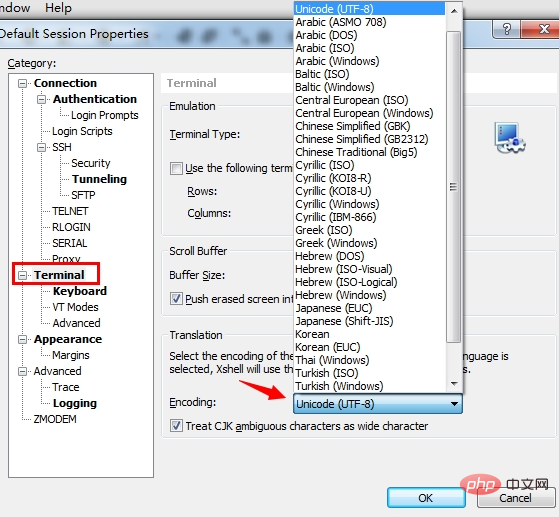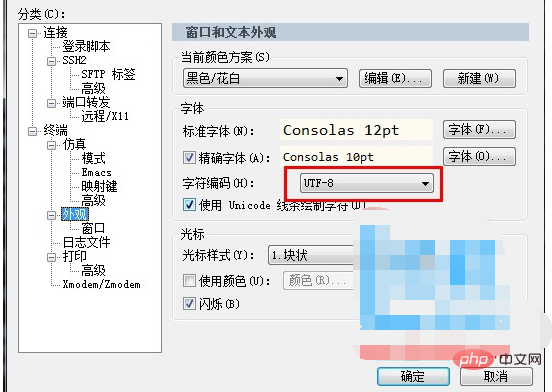 Operation and Maintenance
Operation and Maintenance
 Linux Operation and Maintenance
Linux Operation and Maintenance
 What should I do if Linux displays garbled characters?
What should I do if Linux displays garbled characters?
What should I do if Linux displays garbled characters?

What should I do if Linux displays garbled characters?
Linux terminal displays garbled Chinese characters
Today, we will help our students solve the problem of garbled Chinese characters. This is a problem that worries domestic Linux users. Since most Linux distributions are mainly in English, and English is better than Chinese in terms of versatility and stability, and there are fewer strange bugs. Therefore, it is strongly recommended to use the English system.
We know that our operating system does not matter the Chinese version or the English version. Whether it is Windows or Linux, when the system is released, the whole world has the same kernel. Whether the system is presented to us in English or Chinese completely depends on it. for the language pack of your choice. People from different countries choose the language pack of their own country when installing and using it. The language in the application is not hard-coded. It calls the relevant language according to the system settings. Therefore, an application is written without modification. Users from different countries around the world can use it in their native language interface. This is the so-called internationalization, or i18n for short. This is also the development trend of future software.
So, if I install different language packs and different fonts in the system, how does the system determine the language interface I want and call the relevant fonts? What files and variables in the system control this?
Recommended: "Linux Tutorial"
You can use the locale command to view the character set used by default in the current system
# locale
Under RedHat/CentOS system , the file that records the default language used by the system is /etc/sysconfig/i18n. If the Chinese system is installed by default, the content of i18n is as follows:
LANG="zh_CN.UTF-8" SYSFONT="latarcyrheb-sun16" SUPPORTED="zh_CN.UTF-8:zh_CN:zh"
The LANG variable is the abbreviation of language, which has a slight English foundation. Users can tell at a glance that this variable determines the default language of the system, that is, the system menu, the toolbar language of the program, the default language of the input method, etc. SYSFONT is the abbreviation of system font, which determines which font the system uses by default. The SUPPORTED variable determines the languages supported by the system, that is, the languages the system can display. It should be noted that since computers originated in English-speaking countries, no matter what you set these variables to, English is always supported by default, and no matter what font is used, English fonts are always included.
So how to display Chinese?
1. The system must have a Chinese language pack installed.
# yum -y groupinstall chinese-support
2. Just having a language pack is not enough. We have to set the corresponding character set.
## 临时生效 # export LANG="zh_CN.UTF-8" # 设置为中文 # export LANG="en_US.UTF-8" # 设置为英文,我比较喜欢这样 export ## 永久生效, 编辑/etc/sysconfig/i18n(最好reboot一下) LANG="zh_CN.UTF-8" ## 或者,编辑 /etc/profile配置文件,添加如下一行 export LANG="zh_CN.UTF-8" # 重新载入 # . /etc/profile ## 查看当前的字符集 # echo $LANG
Okay, after The above settings should be able to display Chinese on the terminal.
3. SSH remote terminal is garbled
If the SSH terminal is still garbled, then we also need to set the encoding of the terminal software.
Xshell:

SecureCRT:

4. What should I do if the terminal is still garbled in Chinese? ?
Set up the SSH software and select a font that supports Chinese.
Linux Windows need to modify files between each other, and then the files will be garbled.
After copying, I often find that the Chinese characters are garbled. . The reason is that the default file format in Windows is GBK (gb2312), while Linux is generally UTF-8. The more cumbersome method is to use a program to convert the content into UTF-8 encoding format under Windows, but it is quite troublesome, and it needs to be converted once a file is encountered. Let's introduce how to solve this problem once and for all in Linux, check the encoding of the file and how to convert the file encoding.
In order to avoid these problems, the best way is to uniformly encode. For text files, they are all saved in UTF8 format. Do not use word or notepad under windows. Sublime text or notepad is recommended.
The above is the detailed content of What should I do if Linux displays garbled characters?. For more information, please follow other related articles on the PHP Chinese website!

Hot AI Tools

Undress AI Tool
Undress images for free

Undresser.AI Undress
AI-powered app for creating realistic nude photos

AI Clothes Remover
Online AI tool for removing clothes from photos.

Clothoff.io
AI clothes remover

Video Face Swap
Swap faces in any video effortlessly with our completely free AI face swap tool!

Hot Article

Hot Tools

Notepad++7.3.1
Easy-to-use and free code editor

SublimeText3 Chinese version
Chinese version, very easy to use

Zend Studio 13.0.1
Powerful PHP integrated development environment

Dreamweaver CS6
Visual web development tools

SublimeText3 Mac version
God-level code editing software (SublimeText3)
 Linux how to enable and disable services at boot
Aug 08, 2025 am 10:23 AM
Linux how to enable and disable services at boot
Aug 08, 2025 am 10:23 AM
To manage the startup of Linux services, use the systemctl command. 1. Check the service status: systemctlstatus can check whether the service is running, enabled or disabled. 2. Enable the service startup: sudosystemctlenable, such as sudosystemctlenablenginx. If it is started at the same time, use sudosystemctlenable--nownginx. 3. Disable the service startup: sudosystemctldisable, such as sudosystemctldisablecups. If it is stopped at the same time, use sudosystemctldisabl
 Understanding RAID Configurations on a Linux Server
Aug 05, 2025 am 11:50 AM
Understanding RAID Configurations on a Linux Server
Aug 05, 2025 am 11:50 AM
RAIDimprovesstorageperformanceandreliabilityonLinuxserversthroughvariousconfigurations;RAID0offersspeedbutnoredundancy;RAID1providesmirroringforcriticaldatawith50�pacityloss;RAID5supportssingle-drivefailuretoleranceusingparityandrequiresatleastthre
 Linux how to view the contents of a file
Aug 19, 2025 pm 06:44 PM
Linux how to view the contents of a file
Aug 19, 2025 pm 06:44 PM
ToviewfilecontentsinLinux,usedifferentcommandsbasedonyourneeds:1.Forsmallfiles,usecattodisplaytheentirecontentatonce,withcat-ntoshowlinenumbers.2.Forlargefiles,uselesstoscrollpagebypageorlinebyline,searchwith/search_term,andquitwithq.3.Usemoreforbasi
 Linux how to list all running processes
Aug 08, 2025 am 06:42 AM
Linux how to list all running processes
Aug 08, 2025 am 06:42 AM
Usepsauxforacompletesnapshotofallrunningprocesses,showingdetailedinformationlikeUSER,PID,CPU,andmemoryusage.2.Usetoporhtopforreal-timemonitoringofprocesseswithdynamicupdates,wherehtopoffersamoreintuitiveinterface.3.UsepgreporpidoftoquicklyfindthePIDs
 How to clean up your Linux system
Aug 22, 2025 am 07:42 AM
How to clean up your Linux system
Aug 22, 2025 am 07:42 AM
Removeunusedpackagesanddependencieswithsudoaptautoremove,cleanpackagecacheusingsudoaptcleanorautoclean,andremoveoldkernelsviasudoaptautoremove--purge.2.Clearsystemlogswithsudojournalctl--vacuum-time=7d,deletearchivedlogsin/var/log,andempty/tmpand/var
 how to create an alias in linux
Aug 19, 2025 pm 08:13 PM
how to create an alias in linux
Aug 19, 2025 pm 08:13 PM
The steps to set up alias in Linux are as follows: 1. Temporarily set the use of the alias command such as aliasll='ls-la'; 2. Permanently set the shell configuration file, such as ~/.bashrc, and then execute the source to take effect; 3. Be careful to avoid overwriting the original command and the different shell configurations are independent. Alias can simplify complex commands and improve efficiency, but only after the current shell environment takes effect and closes the terminal, it needs to be reasonably defined and regularly checked for configuration.
 Understanding the Linux Filesystem Hierarchy Standard (FHS)
Aug 06, 2025 pm 04:23 PM
Understanding the Linux Filesystem Hierarchy Standard (FHS)
Aug 06, 2025 pm 04:23 PM
/bin and /sbin store basic commands and system management commands; 2./usr stores user programs and related resources; 3./etc is the configuration file directory; 4./var stores variable data such as logs and caches; 5./home and /root are the home directories of ordinary users and root users; 6./tmp and /run are used for temporary files and runtime data; 7./dev, /proc, /sys provides device and system information interfaces; 8./lib and /lib64 contain library files required for system startup; 9./opt and /srv are used for third-party software and service data respectively; FHS improves system management efficiency through standardized directory structure, making the layout of Linux files clear and consistent, making it easy to maintain and
 192.168.10.1 login portal (Period routing/Asus management page)
Aug 12, 2025 pm 10:18 PM
192.168.10.1 login portal (Period routing/Asus management page)
Aug 12, 2025 pm 10:18 PM
First, confirm that the device is connected to the Wi-Fi of the target router or connected through a network cable; 2. Enter http://192.168.10.1 in the browser address bar and press Enter; 3. Enter the correct username and password (default is often admin/admin or view the back of the router); 4. If it cannot be opened, check whether it is connected to the wrong network, confirm the correct IP address (you can view the default gateway through ipconfig), restart the router, change the browser or turn off the firewall; 5. After logging in, you can modify the Wi-Fi name password, set security options, configure port forwarding, enable guest network, upgrade firmware, etc.; 6. If you forget your password, you can reset the factory settings by pressing and holding the router reset hole for 5-10 seconds, but all configurations will be cleared.






